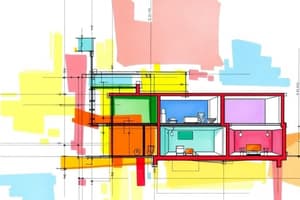Podcast
Questions and Answers
What type of components are normally drawn using the minimum number of views?
What type of components are normally drawn using the minimum number of views?
- Components with a small pin hole
- Components with a large through hole
- Components with a curved surface
- Components that are symmetrical about a center line (correct)
What is the purpose of the right angle bend in the cutting plane?
What is the purpose of the right angle bend in the cutting plane?
- To show the remaining part as a half section
- To go through the center of the small pin hole
- To indicate the position of the cutting plane
- To align with the center of the through hole (correct)
Which part of the object is assumed to be removed in a half section view?
Which part of the object is assumed to be removed in a half section view?
- The bottom half
- The top half
- The right front quarter (correct)
- The left front quarter
What is the purpose of offsetting the cutting plane in a sectional view?
What is the purpose of offsetting the cutting plane in a sectional view?
What is the purpose of crosshatching in a sectional view?
What is the purpose of crosshatching in a sectional view?
What features are shown in the offset section in the front view?
What features are shown in the offset section in the front view?
Flashcards
What type of components are drawn with minimum views?
What type of components are drawn with minimum views?
Components that have equal halves on either side of a central axis.
Why is there a right angle bend in the cutting plane?
Why is there a right angle bend in the cutting plane?
It helps align the cutting plane with the center of a hole, ensuring an accurate representation of the hole in the section view.
What part is removed in a half section view?
What part is removed in a half section view?
The right front quarter of the object is removed to show the internal details.
Why is the cutting plane offset in a sectional view?
Why is the cutting plane offset in a sectional view?
Signup and view all the flashcards
What is the purpose of crosshatching in a sectional view?
What is the purpose of crosshatching in a sectional view?
Signup and view all the flashcards
What features are shown in the offset section of the front view?
What features are shown in the offset section of the front view?
Signup and view all the flashcards
Study Notes
Drawing Components
- Simple or symmetrical components are typically depicted using the minimum number of views to effectively communicate their shape and features.
- Examples include cylindrical objects, spheres, and blocks, which can be fully represented in one or two views.
Right Angle Bend in Cutting Plane
- The right angle bend in the cutting plane facilitates a clear visual representation of internal features without distorting the overall shape of the object.
- It allows for a more straightforward interpretation of complex sections, ensuring that critical details are not overlooked.
Half Section View
- In a half section view, one-half of the object is assumed to be removed, providing insight into the interior structure while showing the exterior.
- This method is particularly effective for symmetrical objects, revealing features such as cavities, holes, or other interior details.
Offsetting the Cutting Plane
- Offsetting the cutting plane in a sectional view enables the depiction of features that are not in a straight line, ensuring that internal details are shown clearly and accurately.
- This technique allows for important non-aligned features to be presented in a single view, enhancing understanding of the component's design.
Crosshatching in Sectional View
- Crosshatching is employed in sectional views to indicate the surfaces that have been cut through, distinguishing them from uncut surfaces.
- Different patterns or angles of lines may be used to signify various materials, improving clarity in understanding the composition of the section.
Offset Section in Front View
- The offset section in the front view displays a comprehensive internal layout, including features such as holes, grooves, or multi-part assemblies that deviate from a straight path.
- This view helps in accurately illustrating how different components interact when viewed along a specific line of section.
Studying That Suits You
Use AI to generate personalized quizzes and flashcards to suit your learning preferences.




